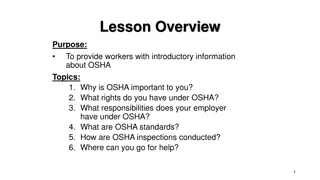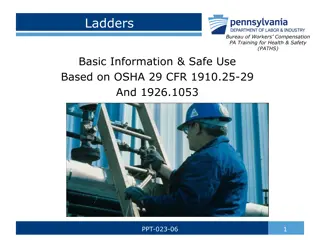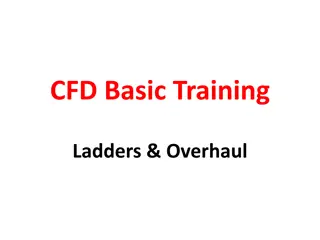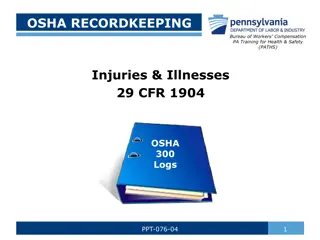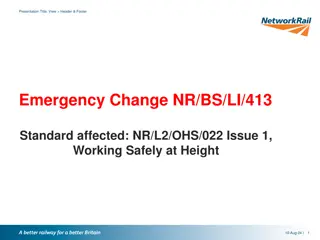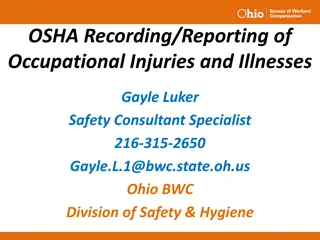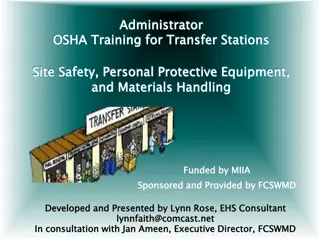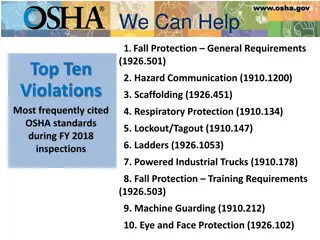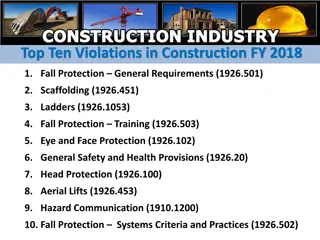OSHA Requirements for Ladders: General Guidelines and Safety Measures
This document outlines the general requirements set by OSHA (Occupational Safety and Health Administration) for ladders to ensure safety in various work environments. It covers aspects such as ladder design, spacing, materials, inspection protocols, and permissible exceptions. Compliance with these regulations is crucial for preventing accidents and injuries related to ladder use in the workplace.
Download Presentation

Please find below an Image/Link to download the presentation.
The content on the website is provided AS IS for your information and personal use only. It may not be sold, licensed, or shared on other websites without obtaining consent from the author. Download presentation by click this link. If you encounter any issues during the download, it is possible that the publisher has removed the file from their server.
E N D
Presentation Transcript
OSHAs NEW 1910.23 Ladders
Application of 1910.23 EACH ladder MUST meet requirements of 1910.23 Std covers ALL ladders, except when the ladder is: Used in emergency operations such as firefighting, rescue, and tactical law enforcement operations, or training for these operations; OR Designed into or is an integral part of machines or equipment
General requirements for ALL ladders Rungs, Steps, and Cleats MUST BE parallel, level, and uniformly spaced when the ladder is in use Rungs, Steps, and Cleats MUST BE spaced not less than 10 and not more than 14 apart Exceptions: elevator shafts and telecommunication towers
General requirements for ALL ladders Steps on STEPSTOOLS MUST BE spaced not less than 8 apart and not more than 12 apart Rungs, Steps, and Cleats MUST have a MINIMUM CLEAR WIDTH of 11.5 on PORTABLE LADDERS and 16 on FIXED LADDERS Exceptions: minimum clear width does not apply to ladders with narrow rungs that are not designed to be stepped on, such as those located on the tapered end of orchard ladders and similar ladders Rungs and steps of manhole entry ladders that are supported by the manhole opening must have a minimum clear width of 9 inches Rungs and steps on rolling ladders used in telecommunication centers must have a minimum clear width of 8 inches Stepstools have a minimum clear width of 10.5 inches
General requirements for ALL ladders WOODEN LADDERS can NOT be coated with any material that may obscure structural defects METAL LADDERS MUST BE made with corrosion- resistant material or protected against corrosion Ladder surfaces MUST BE FREE of puncture and laceration hazards Ladders can ONLY BE USED for the purposes for which they were designed
General requirements for ALL ladders Ladders MUST BE inspected BEFORE INITIAL USE IN EACH WORK SHIFT, and more frequently as necessary, to identify any visible defects that could cause employee injury Any ladder with structural or other defects MUST BE IMMEDIATELY tagged "Dangerous: Do Not Use" or with similar language and REMOVED from service until repaired or replaced
General requirements for ALL ladders Workers MUST face the ladder when climbing up or down Workers MUST use at least one hand to grasp the ladder when climbing up and down Workers are PROHIBITED from carrying any object or load that could cause them to lose their balance and fall while climbing
Portable Ladders Rungs and steps of portable metal ladders MUST BE corrugated, knurled, dimpled, coated with skid-resistant material, or otherwise treated to MINIMIZE the possibility of slipping Stepladders or combination ladder used in a stepladder mode MUST BE equipped with a metal spreader or locking device that securely holds the front and back sections in an OPEN position while the ladder is in use Ladders can NOT be loaded beyond the maximum intended load Note: The maximum intended load includes the total load (weight and force) of the employee and all tools, equipment, and materials being carried.
Portable Ladders Ladders MUST BE USED ONLY on stable and level surfaces unless they are secured or stabilized to prevent accidental displacement NO portable single rail ladders are allowed Ladders can NOT be moved, shifted, or extended while worker is on it
Portable Ladders Ladders used in passageways, doorways, or driveways where they can be displaced by other activities or traffic, MUST: be secured to prevent accidental displacement; or be guarded by a temporary barricade, such as a row of traffic cones or caution tape, to keep the activities or traffic away from the ladder
Portable Ladders Top step of a stepladder can NOT be used as a step Portable ladders used on slippery surfaces MUST BE secured and stabilized The top of a non-self-supporting ladder MUST BE placed so that BOTH side rails are supported, unless the ladder is equipped with a single support attachment
Portable Ladders Portable ladders used to gain access to an upper landing surface MUST extend at least 3 above the landing surface (see Figure D-1) Ladders and ladder sections can NOT be tied or fastened together to provide added length unless they are specifically designed for such use Ladders can NOT be placed on boxes, barrels, or other unstable bases to obtain additional height
Fixed Ladders Fixed ladders MUST BE capable of supporting their maximum intended load Minimum perpendicular distance from the centerline of the steps or rungs, or grab bars, or both, to the nearest permanent object in back of the ladder is 7 Exception: elevator pit ladders, which have a minimum perpendicular distance of 4.5 Grab bars can NOT protrude on the climbing side beyond the rungs of the ladder
Fixed Ladders Side rails of through or sidestep ladders MUST extend 42 ABOVE the top of the access level or landing platform served by the ladder For parapet ladders, the access level is: The roof, if the parapet is cut to permit passage through the parapet; or The top of the parapet, if the parapet is continuous;
Fixed Ladders When a fixed ladder terminates at a hatch (see Figure D-3), the hatch cover MUST: Open with sufficient clearance to provide easy access to/from the ladder Open at least 70 from horizontal if the hatch is counterbalanced Individual-rung ladders are constructed to prevent the employee's feet from sliding off the ends of the rungs (see Figure D-4)
Fixed Ladders Fixed ladders are PROHIBITED from having a pitch greater than 90 degrees from the horizontal The step-across distance from the centerline of the rungs or steps is: For through ladders, not less than 7 and not more than 12 to the nearest edge of the structure, building, or equipment accessed from the ladders For side-step ladders, not less than 15 and not more than 20 to the access points of the platform edge
Fixed Ladders Fixed ladders that do NOT have cages or wells MUST have: A clear width of at least 15 on EACH side of the ladder centerline to the nearest permanent object; and A minimum perpendicular distance of 30 from the centerline of the steps or rungs to the nearest object on the climbing side When UNAVOIDABLE obstructions are encountered, the minimum clearance at the obstruction may be reduced to 24 , provided deflector plates are installed (see Figure D-5)
Figure D-3 -- Example of Counterbalanced Hatch Cover at Roof
Mobile ladder stands and mobile ladder stand platforms Mobile ladder stands and platforms MUST have a STEP WIDTH of at least 16 Steps and platforms MUST BE slip resistant Slip-resistant surfaces MUST BE either an integral part of the design and construction of the mobile ladder stand and platform, or provided as a secondary process or operation, such as dimpling, knurling, shotblasting, coating, spraying, or applying durable slip-resistant tapes Mobile ladder stands and platforms MUST BE capable of supporting at least four (4) times their maximum intended load Wheels or casters under load are capable of supporting their proportional share of four (4) times the maximum intended load, plus their proportional share of the unit's weight
Mobile ladder stands and mobile ladder stand platforms Mobile ladder stands and platforms with a top step height of 4 feet or above MUST have handrails with a vertical height of 29.5 inches to 37 inches , measured from the front edge of a step. Removable gates or non-rigid members, such as chains, may be used instead of handrails in specialize applications Maximum work-surface height of mobile ladder stands and platforms can not exceed four (4) times the shortest base dimension, without additional support. For greater heights, outriggers, counterweights, or comparable means that stabilize the mobile ladder stands and platforms and prevent overturning must be used
Mobile ladder stands and mobile ladder stand platforms Mobile ladder stands and platforms that have wheels or casters MUST BE equipped with a system to impede horizontal movement when an employee is on the stand or platform Mobile ladder stand or platform movement is PROHIBITED when an employee is on it
Mobile ladder stands and mobile ladder stand platforms Steps are uniformly spaced and arranged, with a rise of not more than 10 inches and a depth of not less than 7 inches. The slope of the step stringer to which the steps are attached must not be more than 60 degrees, measured from the horizontal Mobile ladder stands with a top step height above 10 feet MUST have the top step protected on three (3) sides by a handrail with a vertical height of at least 36 inches)
Mobile ladder stands and mobile ladder stand platforms Top steps that are 20 inches or more, front to back, MUST have a mid-rail and toeboard Removable gates or non-rigid members, such as chains, may be used instead of handrails in special-use applications Standing area of mobile ladder stands MUST BE within the base frame Mobile ladder stand or platform movement is PROHIBITED when an employee is on it
Design requirements for Mobile Ladder Stand Platforms Steps of mobile ladder stand platforms MUST meet the requirements of paragraph (e)(2)(i) When the employer demonstrates that the requirement is not feasible, steeper slopes or vertical rung ladders may be used, provided the units are stabilized to prevent overturning Mobile ladder stand platforms with a platform height of 4 to 10 feet MUST have, in the platform area, handrails with a vertical height of at least 36 inches and midrails
Design requirements for Mobile Ladder Stand Platforms All ladder stand platforms with a platform height above 10 MUST have guardrails and toeboards on the exposed sides and ends of the platform Removable gates or non-rigid members, such as chains, may be used on mobile ladder stand platforms instead of handrails and guardrails in special-use applications





